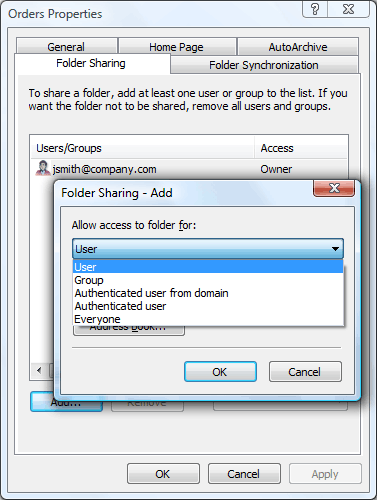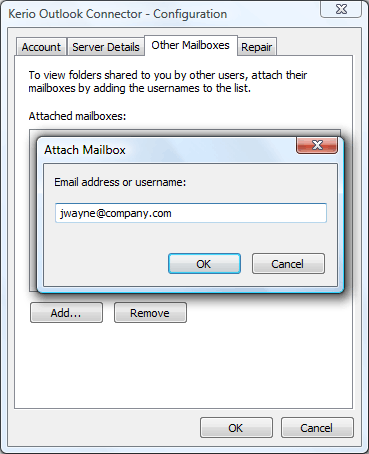Folders in MS Outlook with Kerio Outlook Connector are sorted in standard folder tree. This structure can include multiple roots (folders of the highest level). One root includes all personal folders, another includes public folders (for details on public folders, refer to section 5.9.2 Public folders), other root folders can be added if any shared folders are subscribed. Details on shared folders are focused in section 5.9.1 Folder Sharing.
Folder sharing allows to make a folder with its contents available to another user. The only condition is that the user must have an account on the same mailserver. Any folder of the email account can be shared. Folder type is not important. This implies that it is possible to share email folders, calendars, task folders, notes, etc.
Folder sharing can be used for a wide range of purposes. Let us suggest a few examples. For example, you have an email folder where email orders are saved. This folder can be shared with your colleagues so that they can process the orders even when you are out of your office. You can also share the folder with your boss to make them see the current status of the orders. It is also possible to make a folder with jokes and share it with friends, etc.
To share a folder, follow these instructions:
Right-click a folder and choose Properties from the pop-up menu.
In the properties dialog, select the Folder Sharing tab.
Click on .
This opens a menu where you can select with whom you will share the folder (see figure 5.19 Folder Sharing):
User — a particular user. Enter username (in case that the user belongs to the same domain as the sharer) or username with domain in the
username@domainpattern (e.g.jgraham@company.com) if the user does not belong to the same domain.Group — a particular group. Use the entry to specify name with the domain included in format
group@domain(e.g.sales@company.com).Authenticated user from domain special type of access rights. The folder can be subscribed by all users who have an account in Kerio Connect in the same domain where this folder belongs. In the Domain field, insert the name of the corresponding domain.
Authenticated user — special type of access rights. The folder can be subscribed by all users who have an account in Kerio Connect.
Everyone — special type of access rights, also known as anonymous access. The folder can be subscribed by all users including those who have no account in Kerio Connect. This type of access rights is useful especially for publishing of calendars in the
iCalendarformat.
Now it is necessary to set level for access rights. This can be done through the menu available at the right-bottom corner of the dialog. We can select from the following options:
Administrator — user with these rights can add or remove items in the folder and/or they can also remove the folder. They are also allowed to share the folder with other users. This administrator is not allowed to remove access rights for the user who created the group only.
Editor — the user can edit items in the folder (add and remove items, etc.).
Reader — the user is allowed only to read the folder's items. No editing is allowed.
The sharing can be also removed. To do this, simply check the corresponding line in the list and click on .
Subscription of a folder adds the corresponding shared folder to the subscriber's mailbox (their folder tree). Subscription can be done as follows:
In MS Outlook, go to .
Double-click on Kerio Connect (KOC Offline Edition) and in the account settings, select the Other tab.
Click on and in the Attach Mailbox dialog enter the user's username with domain in format
user_name@domain(e.g.jwayne@company.com).
The subscribed folder is displayed in a separate root folder (the highest level folder). If you subscribe folders of 5 different users, their folders will be saved in 5 different roots. Each root is labeled with the name of the user who shared the folder(s) with us.
Public folders are special type of folders which are shared for reading to all users of the particular domain or of the particular mailserver (it depends on server settings). Public folders help especially share information across the company. For example, company's events are set in the public calendar so that everybody can see when the events happen and view their details, while the person who is responsible for setting of such events can see who is available for the corresponding event. Another advantage of this feature might be for example sharing of public contacts across the company.

